| Warning! Archive of official material released as extra bonus on the discontinued official website. Therefore, it should be considered for consultation only. |
An inside look into the world of Salem released on WGN America official site.
Select from various scenes from Salem TV show to find out the history that inspired the events in the show, as well as various other behind-the scenes content. [1]
Raising the Dead
Episode 1: After the Fall
NECROMANCY

Necromancy technically covers everything from bringing back the dead to fooling around with the Ouija board you got at Toys R Us. It is the magical practice of communication with the dead — either by summoning a spirit or raising the person’s body. The goal is usually to discover secret information, raise the dead, or use the deceased to attack someone.
FALSE: NO NECROMANCY FOR SALEM WITCHES
Several people were accused of Witchcraft in Salem in 1692, however necromancy wasn't one of the indictment. Witches were said to fly, transform into animals, torment children, and make butter go bad, but there was no mention of necromancy or raising the dead.
OLDEST REFERENCE TO NECROMANCY
The oldest literary reference to necromancy can be found in The Odyssey. You might remember it from your high school English class. At one point, Odysseus travels to the underworld and raises the spirits of the dead using spells Circe taught him. Necromancy is also mentioned in The Bible, but The Odyssey is older.
It's the End of the World (as we know it)
Episode 2: The Heart Is A Devil

PURITANS AND THE APOCALYPSE
The Puritans believed that the end of the world was right around the corner. Because of the religious and political turmoil of the time, they truly thought they were living the Apocalypse. The Catholic Church and Church of England were demonic forces. They were the New Jerusalem, the new Kingdom of God. This apocalyptic thinking manifested in everything from sermons to laws to literature. The Day of the Doom, published in 1662, was a Puritan bestseller. It described the Day of Judgment, the destruction of the world, and the punishment of sinners in Hell — just a little light reading.
THE MANY APOCALYPSES-THAT-WEREN’T
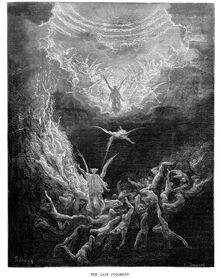
"The Puritans & the Apocalypse" (Gustave Dorè, The Last Judgment)
Everyone loves a good doomsday prophecy. We started predicting the Apocalypse long before colonists came to America. And we didn’t stop just because we got electricity and indoor plumbing. A full list of apocalyptic predictions would be way too long, but the greatest hits include: an Assyrian tablet from 2800 B.C. which claimed some signs of the imminent apocalypse were children disobeying their parents and everyone wanting to write a book. Alarmists in 1910 said that poisonous gas within Halley’s Comet would kill everyone. And a 1950s housewife claimed that aliens told her massive floods would destroy the world on December 21, 1954.
DATING THE APOCALYPSE
When you say the apocalypse is coming, people tend to want an exact date. So various Puritans started predicting when the world would end. One of those Puritans was, yes, Cotton Mather. His first prediction for Doomsday was 1697. When nothing happened that year, he picked 1736 — but then recalculated and chose 1716. When 1716 passed without an apocalypse, he pushed his prediction back a year to 1717. Still nothing. He died in 1728 still certain that the end was near.
TRUE OR FALSE: NO ONE HAS PREDICTED THE END OF THE WORLD SINCE 2001.
Remember 2012? People believed that the Mayan Apocalypse was coming, and that world would end on December 21, 2012. The method of destruction varied: solar storms, the poles flipping, planet X colliding with Earth, an alignment of the planets, total blackout. Modernity hasn’t killed the Apocalypse.
Fallen Angels
Episode 3: The Reckoning
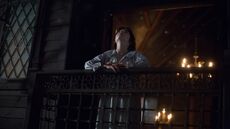
THERE IS NO MENTION OF FALLEN ANGELS IN THE OLD TESTAMENT OF THE BIBLE
There are a couple passages that people believe could refer to fallen angels, but the notion is only spelled out in the New Testament: “Satan, which deceiveth the whole world: he was cast out into the earth, and his angels were cast out with him.”
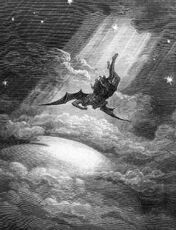
Gustave Dore's engraving from Milton's Paradise Lost, the Fallen Angel
THE OTHER FALLEN
The Devil didn’t fall alone. The other fallen angels are those who followed him and were punished for it — thrown out of heaven, trapped and tormented in Hell. According to some legends, they fell for 9 days. The total number of fallen angels changes from one text to another, and the accounts can get very specific. One writer says 200 angels fell, while another says it was exactly 133,306,668 angels.
NAMING THE FALLEN
Uriel is sometimes referred to as an archangel, but is always considered a powerful angel of God. Belial is a fallen angel sometimes equated with Satan. Gadreel is a fallen angel who supposedly led Eve astray. Abaddon is sometimes referred to as a demon, sometimes as the angel of the bottomless pit.
SAMAEL
The Sentinel refers to the Devil Boy as Samael. But the “real” Samael has a much more complicated backstory. In the Jewish tradition, Samael is an important archangel who is portrayed as both good and evil. On the one hand, he rules over part of heaven, and is the commander of two million angels. On the other hand, he is the angel of death. Some stories say Samael was the serpent in the Garden of Eden, fathered a host of demon children, and is the chief of evil spirits. That sounds more like our Devil Boy.
You Are What You Ate
Episode 4: Night's Black Agents
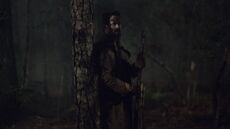
TRIVIA: CANNIBALS
Cannibalism makes an appearance in the Malleus Maleficarum, the best know witch-hunting manual. Specifically, the Malleus Maleficarum claims that certain witches are in the habit of eating infant children and describes an eyewitness account of the act.
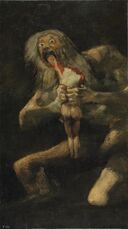
Francisco Goya, Saturn Devouring His Son
WITCHES AND CANNIBALISM
During European witch hunts in the 1500s, cannibalism became an established part of witches’ crimes. Many accused witches confessed to cannibalistic acts in places like Germany and France, and it was widely believed that witches’ salve was made of the flesh of children. Witches were also said to gather for diabolic feasts, where they drank wine and ate babies.
COLONIAL CANNIBALS
The witches in Salem would not be the first American colonists to become cannibals. Colonists in Jamestown resorted to cannibalism during the winter of 1609–1610, a period called the “Starving Time.” George Percy, one of the colonists, wrote an account of the experience, explaining how the colonists ate all their horses and livestock before moving on to dogs, cats, rats, mice, and any fish they could find. They then moved onto eating boots and other leather goods, before searching the woods for snakes and roots to eat. Finally, they started digging up human corpses.
Murderous Barbers
Episode 5: The Commonwealth of Hell
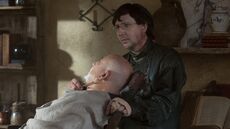
Thomas Dinley
THE BARBER-SURGEON
From the Middle Ages up until the late 18th century, you wouldn’t go to a physician for your health problems. You would go to a barber-surgeon. Barber-surgeons provided a variety of services. They set bones, picked lice from hair, pulled teeth, lanced abscesses, cut out gallstones, performed surgery, sold medicines, and, of course, cut hair.
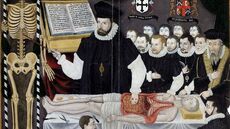
John Banister lecturing on anatomy by anonymous ca.16th Century
BLOODLETTING
The colors of the red and white barber shop pole originally referenced the blood and napkins associated with bloodletting. Bloodletting was one of the main tasks of a barber-surgeon, and the red and white pole served as a clear advertisement for his services. The blue in some barbershop poles is said to represent veins.
THE DEMON BARBER OF FLEET STREET
Thomas Dinley and Sweeney Todd have more in common than their murderous tendencies. In many versions of the Sweeney Todd story, Todd is also identified as a barber-surgeon. In one 1973 play, Sweeney Todd stages a public competition against another man to see who could perform the best tooth-extraction as well as the best shave.
Stealing The Babe
Episode 6: Wednesday's Child
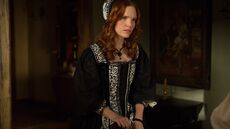
Anne Hale, Salem's "Mother Gothel"
MOTHER GOTHEL
Arguably the most famous child-stealing witch is Mother Gothel, who appears in the German fairy tale “Rapunzel” collected by the Brothers Grimm. The story begins with a pregnant woman who develops extreme cravings for the rapunzel plant in her neighbor’s garden. Her husband repeatedly breaks into the garden and steals the plant, only to be caught by the neighbor — who is, of course, an evil witch. The witch, Mother Gothel (or Dame Gothel in some versions), agrees to let the husband go if the couple gives her their baby at birth. They agree. Eventually, Mother Gothel names the girl Rapunzel and locks her up in a tower that’s only accessible by climbing the girl’s long golden hair.
MIDWIVES AND WITCHCRAFT
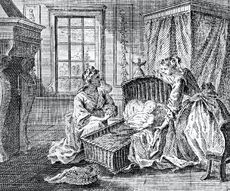
Throughout history, midwives were often suspected of being witches. They were regularly accused of killing or stealing unborn children, as well as snatching newborns. One inquisitor in medieval times claimed: “Midwives who work harmful magic kill fetuses in the womb in different ways, procure a miscarriage, and … offer newly born children to evil spirits.”
IT WAS A WIDESPREAD BELIEF IN EUROPE AND AMERICA THAT WITCHES STOLE CHILDREN
European and American belief in witchcraft has pretty much always been associated with witches stealing babies and young children. Unlike Anne Hale, however, they generally weren’t taking the children to raise as their own. Typically, the witches were said to steal children in order to kill them as part of occult rituals and sacrifices.
Do You Hear The Children Sing?
Episode 7: The Man Who Was Thursday
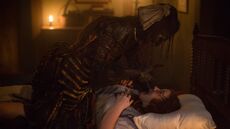
Gloriana suffering a spectral attack
“SOLOMON GRUNDY”
The nursery rhyme "Solomon Grundy" first appeared in print over 100 years after the Salem Witch Trials occurred. “Solomon Grundy” first appeared in James Orchard Halliwell’s Nursery Rhymes of England in 1842. The Salem witch trials took place in 1692–1963.
SOLOMON GRUNDY' LYRICS
The song sung over and over in Salem is an actual English nursery rhyme titled “Solomon Grundy.” The complete lyrics are: Solomon Grundy, / Born on a Monday, / Christened on Tuesday, / Married on Wednesday, / Took ill on Thursday, / Worse on Friday, / Died on Saturday, / Buried on Sunday. / That was the end / Of Solomon Grundy.
OTHER APPEARANCES
Even beyond Salem, Solomon Grundy has not been limited to children’s nursery rhymes. He has popped up as a Sesame Street character, as a DC Comics zombie villain, in an ad for the National Savings Committee, and in many, many songs.
THE DOOR(S) TO HELL
Episode 8: Friday's Knights
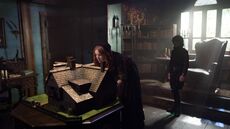
A spooky appearance
KNOCK KNOCK
The door to Hell in the Sibley mansion is hardly the first example of an entrance to Hell. From the River Acheron in Greece to the City of Ghosts in China to St. Patrick’s Purgatory in Ireland, human history and legends are full of places said to be portals to Hell.
DOORS TO HELL IN NORTH AMERICA
North America is full of supposed portals and gates and doors to Hell. Stull Cemetery in Kansas is allegedly a gateway to Hell. The Gates of Guinee in New Orleans are said to offer entrance into the voodoo land of the dead. Local legends claim that the woods near Hellam Township, Pennsylvania hold the Seven Gates of Hell. One urban legend even says that the entrance to Hell is in a series of storm drains in Clifton, New Jersey.
AN ANCIENT GREEK HELLGATE
The ancient city of Hierapolis in modern-day Turkey contained a Temple of Pluto that was said to be a portal to the underworld. One Greek philosopher around the year 0 AD wrote that “any animal that passes inside meets instant death.” Pilgrims would travel from all over the classical world to make sacrifices there. As it turns out, toxic vapors waft out of tunnels underneath the site. Even now, the poisonous fumes kill any birds that fly or nest too close to the ruins.
Saturday Mourning
Episode 9: Saturday Mourning
INCESTUOUS WITCHES
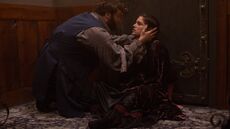
Grieving on the threshold of Hell
Witches were, as a rule, associated with what were considered the most “anti-human” acts: orgies, infanticide, cannibalism, bestiality and, of course, incest. At least one group in New Guinea, the Etoro, believed that incest bred witchcraft. The act of incest was said to transform a brother and sister into witches, and their child would be born a witch. In North America, several indigenous groups similarly believed that witches gained their power by committing incest. In most cultures, incest was totally and overwhelmingly repugnant. People who did such things might do anything, and could not be considered human beings.
Trivia:LINKED ACCUSATIONS OF INCEST AND WITCHCRAFT

Queen Anne Boleyn
Incest and witchcraft were practically inseparable across numerous cultures and continents, including Europe, North America, and Africa.
THE OTHER ANNE
There is another Anne associated with witchcraft and incest: Anne Boleyn. Anne was the second of King Henry VIII’s wives. Her alleged status as a witch was a myth spread by her opponents, who also said she had a sixth finger, a boil under her chin, and a protruding tooth. In the end, she was tried and executed not for witchcraft, but for treason supported by adultery. Among her alleged lovers was her brother, George Boleyn. George’s wife Jane Rochford testified in court that she’d witnessed the affair.
Black Sunday
Episode 10: Black Sunday
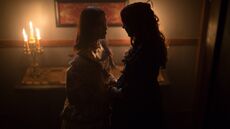
The Queens of Black Sunday
THE ROMAN CENTURION
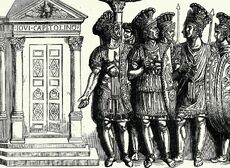
The Roman Centurion
Christianity does not hold a monopoly on self-sacrifice. At least one ancient Roman legend closely parallels Cotton’s decision to save Salem by sacrificing himself. The Roman historian Livy wrote of a time when an oracle foretold the fall of Rome. The Oracle's message warned that the city would crumble unless it sacrificed that which it held most dear. A chasm opened in the center of the Forum to accept that offering. Centurion Marcus Curtius interpreted “that which it held most dear” as referring to Rome’s soldiers, and sacrificed his own life by riding his horse into the pit. According to legend, the chasm closed over his head and Rome was saved.
WHICH MYTHICAL FIGURE DID NOT ENTER HELL IN ORDER TO SAVE SOMEONE?
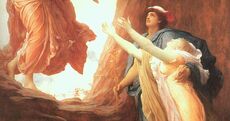
Frederick Leighton, The Return of Persephone
Izanagi is a Japanese deity who entered the Netherworld in an attempt to retrieve his deceased wife, Izanami. In Mongolian mythology, King Gesar launched an invasion into the underworld to save his mother. Persephone, on the other hand, was kidnapped by Hades and did not enter the underworld willingly.
THE CHRISTIAN SAVIOR
Cotton’s sacrifice makes sense in Salem partly because Christianity is essentially built on the belief that one willing sacrifice can save the lives and souls of many. According to the Bible, Jesus willingly sacrificed himself and died on the cross, thereby saving all of humanity from their sins. One of his titles is “Messiah,” which means savior or liberator.
| |||||
|
| ||||||||||||||
